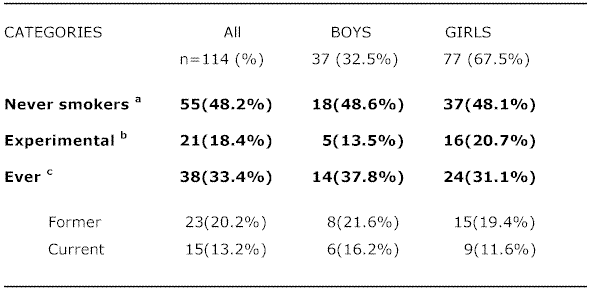
|
|||
|---|---|---|---|
|
|
Social context, smoking initiation and physical activity in adolescents |
|
|
|
Instituto de Investigación sobre el Trabajo Universidad de Guanajuato (México) |
Lucía Rodríguez Guzmán Francisco José Díaz Cisneros María Magdalena Nájera Garcidueñas luciarg@prodigy.net.mx |
|
|
|
|
http://www.efdeportes.com/ Revista Digital - Buenos Aires - Año 9 - N° 67 - Diciembre de 2003 |
|
|
1 / 1
Introduction
In our country cardiovascular disease is the first cause of mortality. We have previously shown that Mexican adolescents are at high risk for heart disease due their unfavourable blood lipid profiles and poor dietary habits (Díaz, F J., et al., 1997). In a follow-up study, we identify the prevalence of smoking and patterns of physical activity in the same population.
Physical inactivity and smoking behaviour are important health risk factors, too. Nevertheless more and more young people are beginning to smoke. In addition physical activity practices are decreasing.
The purpose of this study was to report the prevalence of smoking and patterns of physical activity in adolescent's students.
MethodFour hundred - fourteen students (132 males and 282 females, mean age=16.3 years) from the University of Guanajuato in Mexico, participated in this study.
Smoking habits and physical activity profile where obtained according to the W.H.O. protocol, and Aaron and Kriska (1999), Modifiable Activity Questionnaire for Adolescents.
Fourteen laboratory and health promotion lectures about smoking hazards and physical exercise.
ResultsNearly, 52% of the study sample (114 adolescents) reported smoking at least once in their lives, while 13% reported that they were current smokers (there were not significant differences between genders).
Table 1- SMOKING STATUS IN HIGH SCHOOL STUDENTS

a Never smokernever tried smoking.
b Experimentalexperimented with cigarette at least once.
c Everhas smoked one or more full cigarettes. This category includes former and current smokers.
Table 2- SITUATION OF FIRST CIGARETTE USE (%)

Table 2 describes situations for first cigarette use of participants. 17% first tried cigarettes with a family member,
64% with someone their own age, 50% obtained their first cigarette from friends.
The boys reported that they participated in physical activity 6 hrs. Every 2 weeks, while the females reported only performing 4 hrs of activity. Only 30% of all students reported physical activity habits that met basic ACSM (American College Sports Medicine) recommendations.
Discussion
This study examined the prevalence of cigarette smoking in adolescents. Our data reveal that more than half the participants in this project had smoked at least one time on their lives (former, experimental and current smokers). Curiosity was the main reason for start smoking in both genders.
The prevalence of tobacco use in this study (13%) was much lower than that reported among adolescents in other countries: Canada (23%), France (35%), Germany (25%), Chile (31%), (WHO, 1999). U.S. (39.6%) (CDC, 1999). In our report, health education sessions and physical activity promotion appear to be related to smoking cessation.
The results are consistent with previous research in showing that the onset of smoking at a youth age may be associated with social influences. In this context, efforts to discourage smoking, such as health education and physical activity promotion, might deter smoking initiation.
Giving up smoking is not easy, nicotine is powerfully addictive. Every day, worldwide there are between 82,000 and 99,000 young people starting to smoke and risking rapid addiction to nicotine. According to World Health Organization, adolescents are the most specific targets of cessation and prevention efforts.
WHO and UNESCO recognize the great potential of physical activity for health, and the value of health education in schools (from the primary level to university). The worldwide challenge is to develop health promotion scenarios for the Active Living Project.
Conclusion
Although smoking prevalence is not as high compared to other populations, physical activity levels are low.
Interventions to prevent early use of tobacco and increase the level of physical activity are needed. The current results may provide additional justification for school policies to deter smoking.
References
-
Aaron, D.J. and A. M. Kriska. Modifiable Activity Questionnaire for Adolescents. Med. Sci. Sports, Exerc., 29(6): S79-S82, suppl. June 1999.
-
Aaron, D.J., et al. The epidemiology of leisure physical activity in an adolescent population. . Med. Sci. Sports, Exerc., 25: 847-853, 1993.
-
CDC, U.S. Department of Health and Human Services. Youth risk behavior Surveillance System. 1999.
-
Díaz, F.J., et al. The effect of diet and exercise upon cardiovascular risk factor in adolescents. Med. Sci. Sports Exerc., 29 (5): 1354, suppl. May 1997.
-
UNESCO. Programs for and with youth. Strategy and action. http://www.unesco.org/youth
-
W.H.O. Tobacco or health. A global status report. 1999.
-
W.H.O. Statement on Active Living. Fourth International Conference on Health Promotion. Jakarta 21-25, July 1997. http://who.org.2000.
| |
|
|---|---|
|
revista
digital · Año 9 · N° 67 | Buenos Aires, Diciembre 2003 |
|